Contracts and Procurement in the RAH Project: A Detailed Report
VerifiedAdded on 2023/01/13
|10
|2793
|22
Report
AI Summary
This report provides an analysis of the contracts and procurement management within the Royal Adelaide Hospital (RAH) project, a significant infrastructure undertaking. The report examines various critical areas including strategic issues, risk management, stakeholder concerns, resource allocation, and budget/financial considerations. It emphasizes the need for strategic business planning, effective contract management, and proactive risk planning to mitigate potential challenges. Furthermore, the report recommends strategies for stakeholder engagement, resource optimization, and budget control to ensure the successful delivery of the RAH project. It also highlights the importance of procurement management and its associated risks, offering insights into best practices for contract administration and project outcomes. The report concludes by summarizing the key steps in the procurement process and the responsibilities of procurement and project managers, all while stressing the importance of risk management to avoid potential pitfalls.
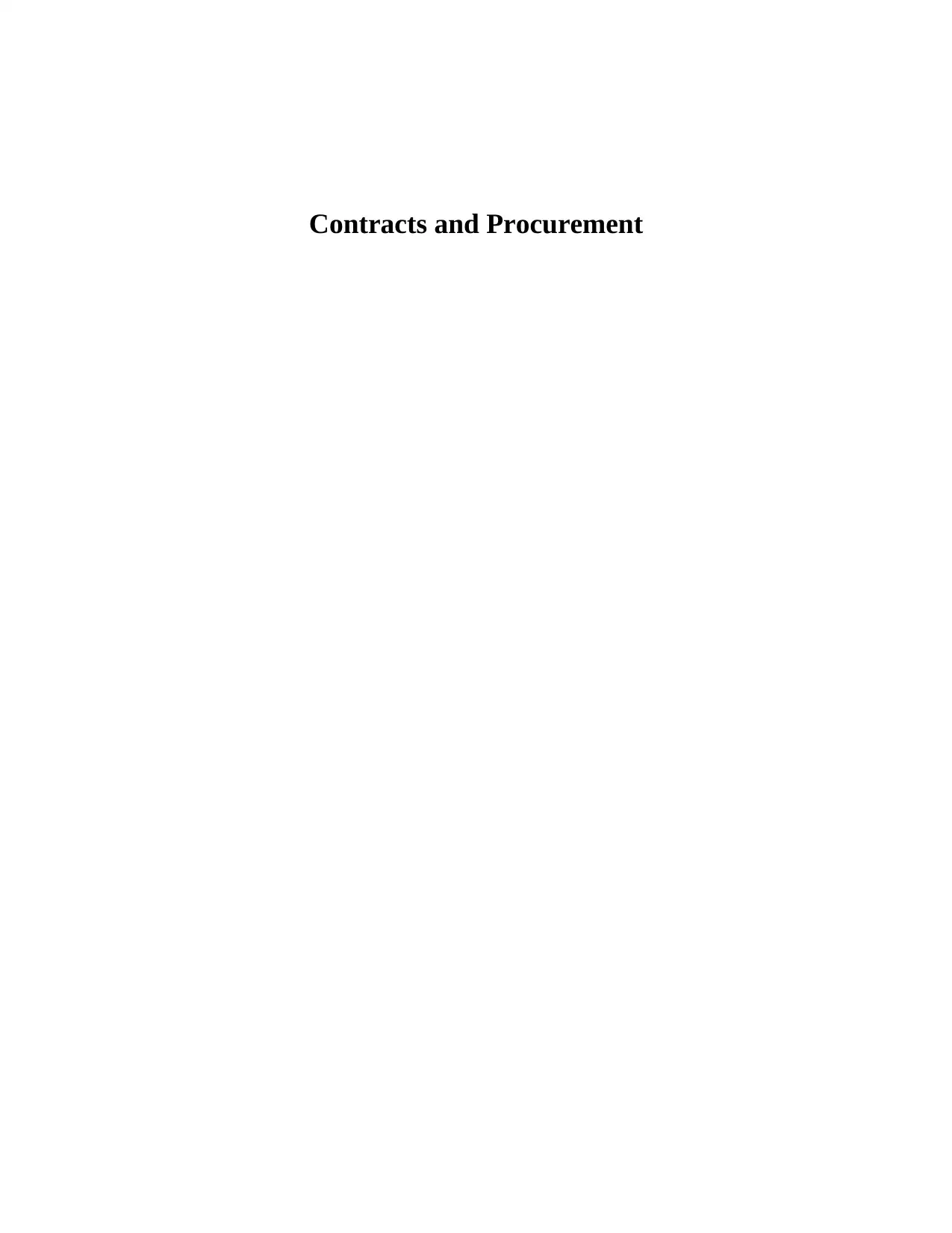
Contracts and Procurement
Paraphrase This Document
Need a fresh take? Get an instant paraphrase of this document with our AI Paraphraser
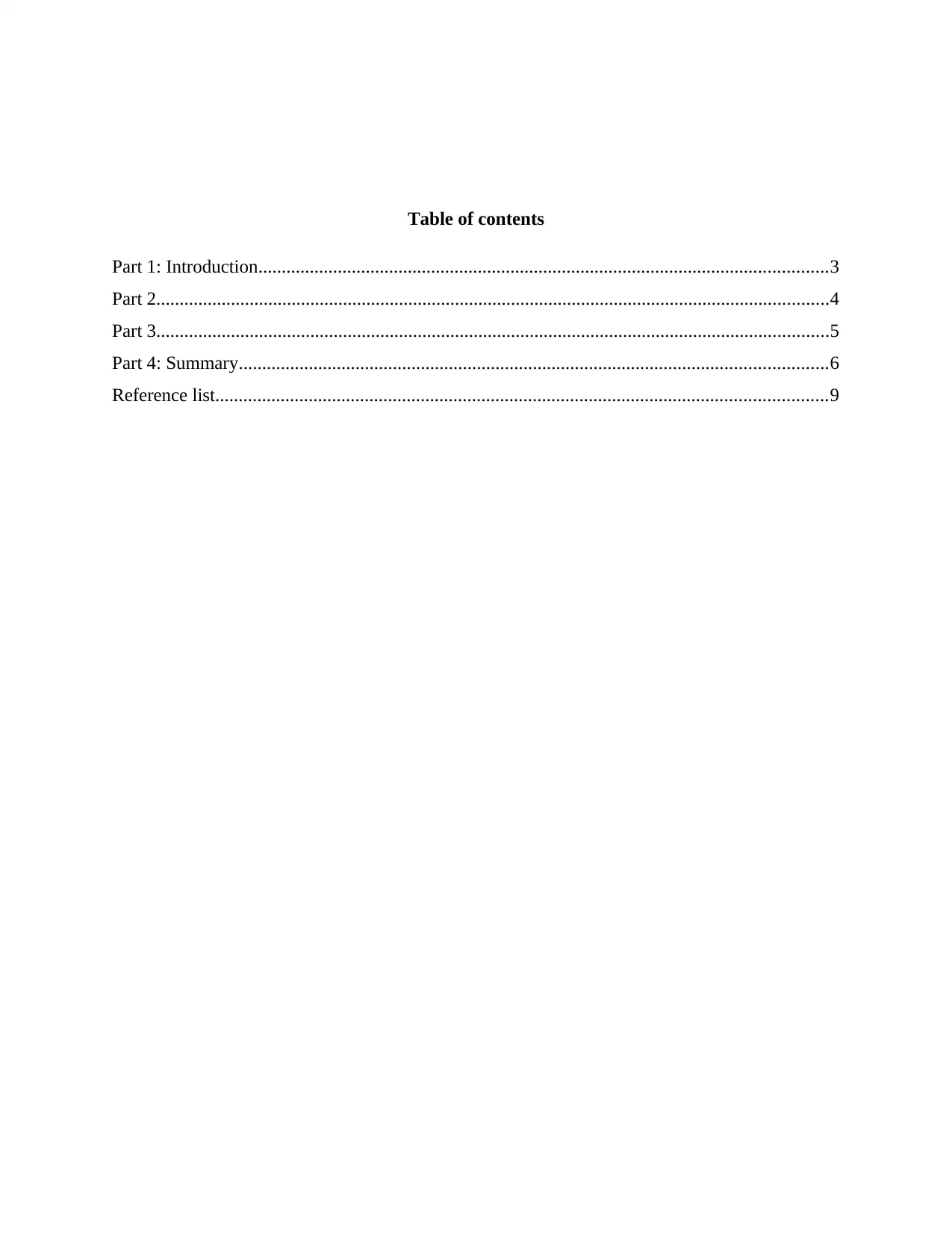
Table of contents
Part 1: Introduction..........................................................................................................................3
Part 2................................................................................................................................................4
Part 3................................................................................................................................................5
Part 4: Summary..............................................................................................................................6
Reference list...................................................................................................................................9
Part 1: Introduction..........................................................................................................................3
Part 2................................................................................................................................................4
Part 3................................................................................................................................................5
Part 4: Summary..............................................................................................................................6
Reference list...................................................................................................................................9
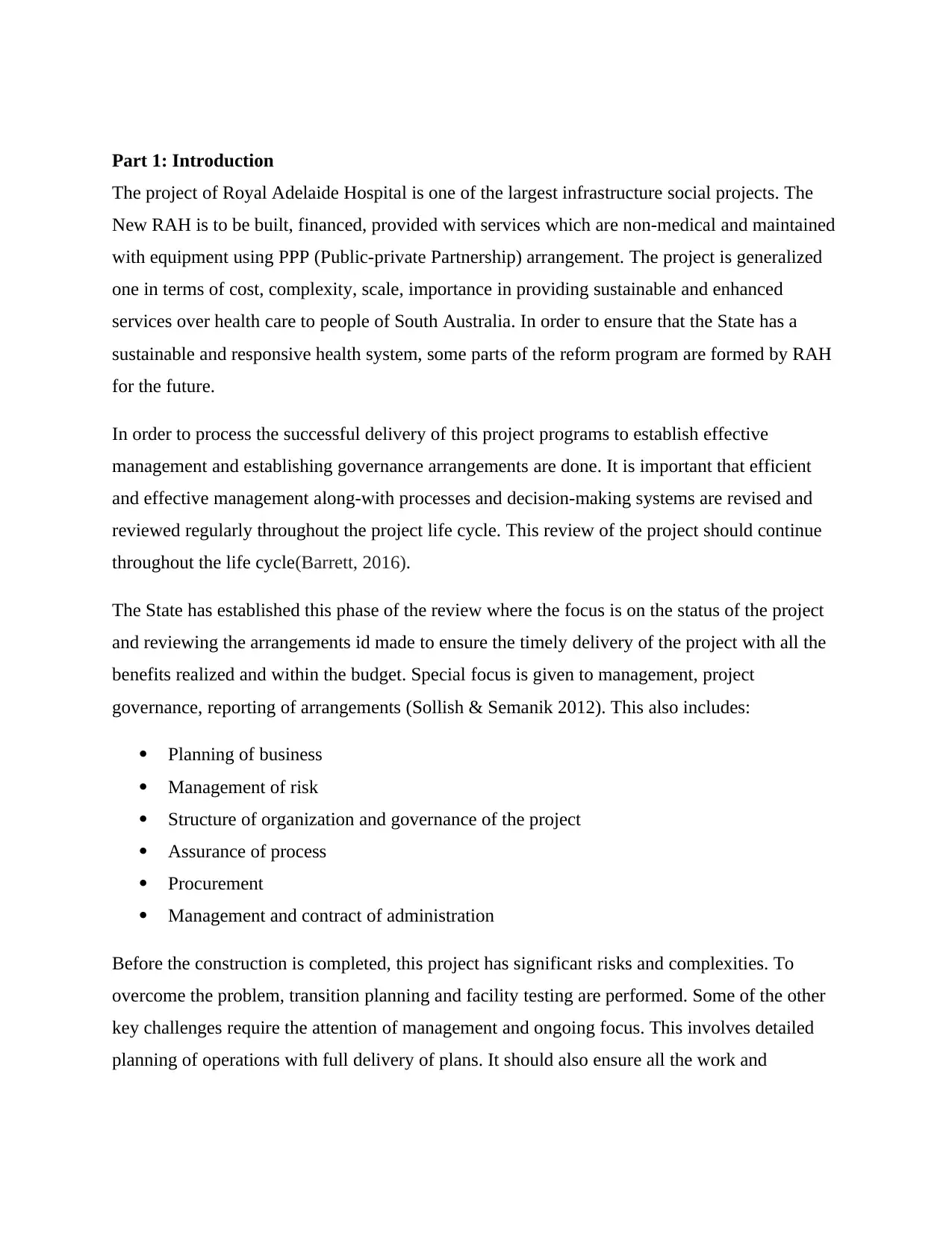
Part 1: Introduction
The project of Royal Adelaide Hospital is one of the largest infrastructure social projects. The
New RAH is to be built, financed, provided with services which are non-medical and maintained
with equipment using PPP (Public-private Partnership) arrangement. The project is generalized
one in terms of cost, complexity, scale, importance in providing sustainable and enhanced
services over health care to people of South Australia. In order to ensure that the State has a
sustainable and responsive health system, some parts of the reform program are formed by RAH
for the future.
In order to process the successful delivery of this project programs to establish effective
management and establishing governance arrangements are done. It is important that efficient
and effective management along-with processes and decision-making systems are revised and
reviewed regularly throughout the project life cycle. This review of the project should continue
throughout the life cycle(Barrett, 2016).
The State has established this phase of the review where the focus is on the status of the project
and reviewing the arrangements id made to ensure the timely delivery of the project with all the
benefits realized and within the budget. Special focus is given to management, project
governance, reporting of arrangements (Sollish & Semanik 2012). This also includes:
Planning of business
Management of risk
Structure of organization and governance of the project
Assurance of process
Procurement
Management and contract of administration
Before the construction is completed, this project has significant risks and complexities. To
overcome the problem, transition planning and facility testing are performed. Some of the other
key challenges require the attention of management and ongoing focus. This involves detailed
planning of operations with full delivery of plans. It should also ensure all the work and
The project of Royal Adelaide Hospital is one of the largest infrastructure social projects. The
New RAH is to be built, financed, provided with services which are non-medical and maintained
with equipment using PPP (Public-private Partnership) arrangement. The project is generalized
one in terms of cost, complexity, scale, importance in providing sustainable and enhanced
services over health care to people of South Australia. In order to ensure that the State has a
sustainable and responsive health system, some parts of the reform program are formed by RAH
for the future.
In order to process the successful delivery of this project programs to establish effective
management and establishing governance arrangements are done. It is important that efficient
and effective management along-with processes and decision-making systems are revised and
reviewed regularly throughout the project life cycle. This review of the project should continue
throughout the life cycle(Barrett, 2016).
The State has established this phase of the review where the focus is on the status of the project
and reviewing the arrangements id made to ensure the timely delivery of the project with all the
benefits realized and within the budget. Special focus is given to management, project
governance, reporting of arrangements (Sollish & Semanik 2012). This also includes:
Planning of business
Management of risk
Structure of organization and governance of the project
Assurance of process
Procurement
Management and contract of administration
Before the construction is completed, this project has significant risks and complexities. To
overcome the problem, transition planning and facility testing are performed. Some of the other
key challenges require the attention of management and ongoing focus. This involves detailed
planning of operations with full delivery of plans. It should also ensure all the work and
⊘ This is a preview!⊘
Do you want full access?
Subscribe today to unlock all pages.

Trusted by 1+ million students worldwide
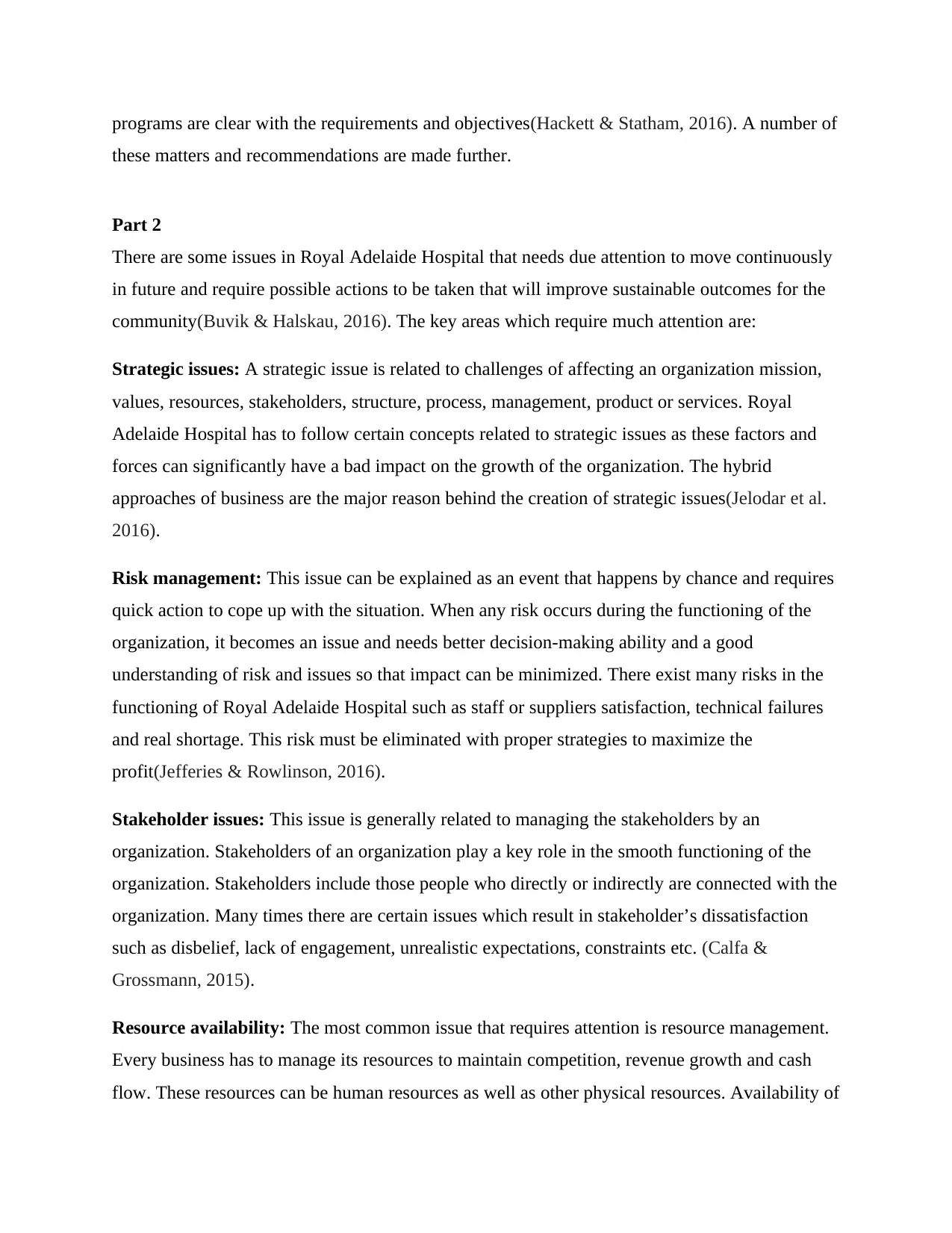
programs are clear with the requirements and objectives(Hackett & Statham, 2016). A number of
these matters and recommendations are made further.
Part 2
There are some issues in Royal Adelaide Hospital that needs due attention to move continuously
in future and require possible actions to be taken that will improve sustainable outcomes for the
community(Buvik & Halskau, 2016). The key areas which require much attention are:
Strategic issues: A strategic issue is related to challenges of affecting an organization mission,
values, resources, stakeholders, structure, process, management, product or services. Royal
Adelaide Hospital has to follow certain concepts related to strategic issues as these factors and
forces can significantly have a bad impact on the growth of the organization. The hybrid
approaches of business are the major reason behind the creation of strategic issues(Jelodar et al.
2016).
Risk management: This issue can be explained as an event that happens by chance and requires
quick action to cope up with the situation. When any risk occurs during the functioning of the
organization, it becomes an issue and needs better decision-making ability and a good
understanding of risk and issues so that impact can be minimized. There exist many risks in the
functioning of Royal Adelaide Hospital such as staff or suppliers satisfaction, technical failures
and real shortage. This risk must be eliminated with proper strategies to maximize the
profit(Jefferies & Rowlinson, 2016).
Stakeholder issues: This issue is generally related to managing the stakeholders by an
organization. Stakeholders of an organization play a key role in the smooth functioning of the
organization. Stakeholders include those people who directly or indirectly are connected with the
organization. Many times there are certain issues which result in stakeholder’s dissatisfaction
such as disbelief, lack of engagement, unrealistic expectations, constraints etc. (Calfa &
Grossmann, 2015).
Resource availability: The most common issue that requires attention is resource management.
Every business has to manage its resources to maintain competition, revenue growth and cash
flow. These resources can be human resources as well as other physical resources. Availability of
these matters and recommendations are made further.
Part 2
There are some issues in Royal Adelaide Hospital that needs due attention to move continuously
in future and require possible actions to be taken that will improve sustainable outcomes for the
community(Buvik & Halskau, 2016). The key areas which require much attention are:
Strategic issues: A strategic issue is related to challenges of affecting an organization mission,
values, resources, stakeholders, structure, process, management, product or services. Royal
Adelaide Hospital has to follow certain concepts related to strategic issues as these factors and
forces can significantly have a bad impact on the growth of the organization. The hybrid
approaches of business are the major reason behind the creation of strategic issues(Jelodar et al.
2016).
Risk management: This issue can be explained as an event that happens by chance and requires
quick action to cope up with the situation. When any risk occurs during the functioning of the
organization, it becomes an issue and needs better decision-making ability and a good
understanding of risk and issues so that impact can be minimized. There exist many risks in the
functioning of Royal Adelaide Hospital such as staff or suppliers satisfaction, technical failures
and real shortage. This risk must be eliminated with proper strategies to maximize the
profit(Jefferies & Rowlinson, 2016).
Stakeholder issues: This issue is generally related to managing the stakeholders by an
organization. Stakeholders of an organization play a key role in the smooth functioning of the
organization. Stakeholders include those people who directly or indirectly are connected with the
organization. Many times there are certain issues which result in stakeholder’s dissatisfaction
such as disbelief, lack of engagement, unrealistic expectations, constraints etc. (Calfa &
Grossmann, 2015).
Resource availability: The most common issue that requires attention is resource management.
Every business has to manage its resources to maintain competition, revenue growth and cash
flow. These resources can be human resources as well as other physical resources. Availability of
Paraphrase This Document
Need a fresh take? Get an instant paraphrase of this document with our AI Paraphraser
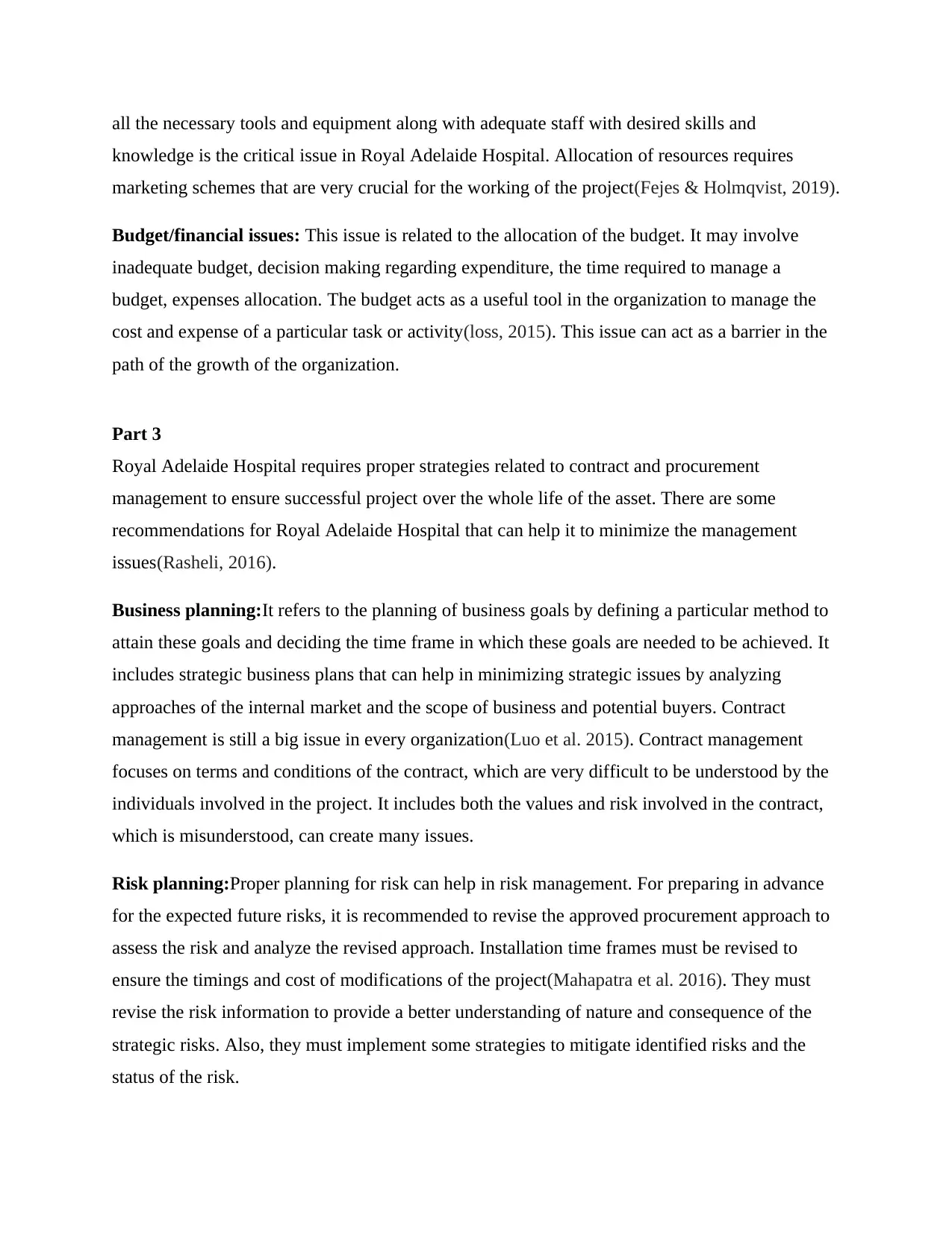
all the necessary tools and equipment along with adequate staff with desired skills and
knowledge is the critical issue in Royal Adelaide Hospital. Allocation of resources requires
marketing schemes that are very crucial for the working of the project(Fejes & Holmqvist, 2019).
Budget/financial issues: This issue is related to the allocation of the budget. It may involve
inadequate budget, decision making regarding expenditure, the time required to manage a
budget, expenses allocation. The budget acts as a useful tool in the organization to manage the
cost and expense of a particular task or activity(loss, 2015). This issue can act as a barrier in the
path of the growth of the organization.
Part 3
Royal Adelaide Hospital requires proper strategies related to contract and procurement
management to ensure successful project over the whole life of the asset. There are some
recommendations for Royal Adelaide Hospital that can help it to minimize the management
issues(Rasheli, 2016).
Business planning:It refers to the planning of business goals by defining a particular method to
attain these goals and deciding the time frame in which these goals are needed to be achieved. It
includes strategic business plans that can help in minimizing strategic issues by analyzing
approaches of the internal market and the scope of business and potential buyers. Contract
management is still a big issue in every organization(Luo et al. 2015). Contract management
focuses on terms and conditions of the contract, which are very difficult to be understood by the
individuals involved in the project. It includes both the values and risk involved in the contract,
which is misunderstood, can create many issues.
Risk planning:Proper planning for risk can help in risk management. For preparing in advance
for the expected future risks, it is recommended to revise the approved procurement approach to
assess the risk and analyze the revised approach. Installation time frames must be revised to
ensure the timings and cost of modifications of the project(Mahapatra et al. 2016). They must
revise the risk information to provide a better understanding of nature and consequence of the
strategic risks. Also, they must implement some strategies to mitigate identified risks and the
status of the risk.
knowledge is the critical issue in Royal Adelaide Hospital. Allocation of resources requires
marketing schemes that are very crucial for the working of the project(Fejes & Holmqvist, 2019).
Budget/financial issues: This issue is related to the allocation of the budget. It may involve
inadequate budget, decision making regarding expenditure, the time required to manage a
budget, expenses allocation. The budget acts as a useful tool in the organization to manage the
cost and expense of a particular task or activity(loss, 2015). This issue can act as a barrier in the
path of the growth of the organization.
Part 3
Royal Adelaide Hospital requires proper strategies related to contract and procurement
management to ensure successful project over the whole life of the asset. There are some
recommendations for Royal Adelaide Hospital that can help it to minimize the management
issues(Rasheli, 2016).
Business planning:It refers to the planning of business goals by defining a particular method to
attain these goals and deciding the time frame in which these goals are needed to be achieved. It
includes strategic business plans that can help in minimizing strategic issues by analyzing
approaches of the internal market and the scope of business and potential buyers. Contract
management is still a big issue in every organization(Luo et al. 2015). Contract management
focuses on terms and conditions of the contract, which are very difficult to be understood by the
individuals involved in the project. It includes both the values and risk involved in the contract,
which is misunderstood, can create many issues.
Risk planning:Proper planning for risk can help in risk management. For preparing in advance
for the expected future risks, it is recommended to revise the approved procurement approach to
assess the risk and analyze the revised approach. Installation time frames must be revised to
ensure the timings and cost of modifications of the project(Mahapatra et al. 2016). They must
revise the risk information to provide a better understanding of nature and consequence of the
strategic risks. Also, they must implement some strategies to mitigate identified risks and the
status of the risk.
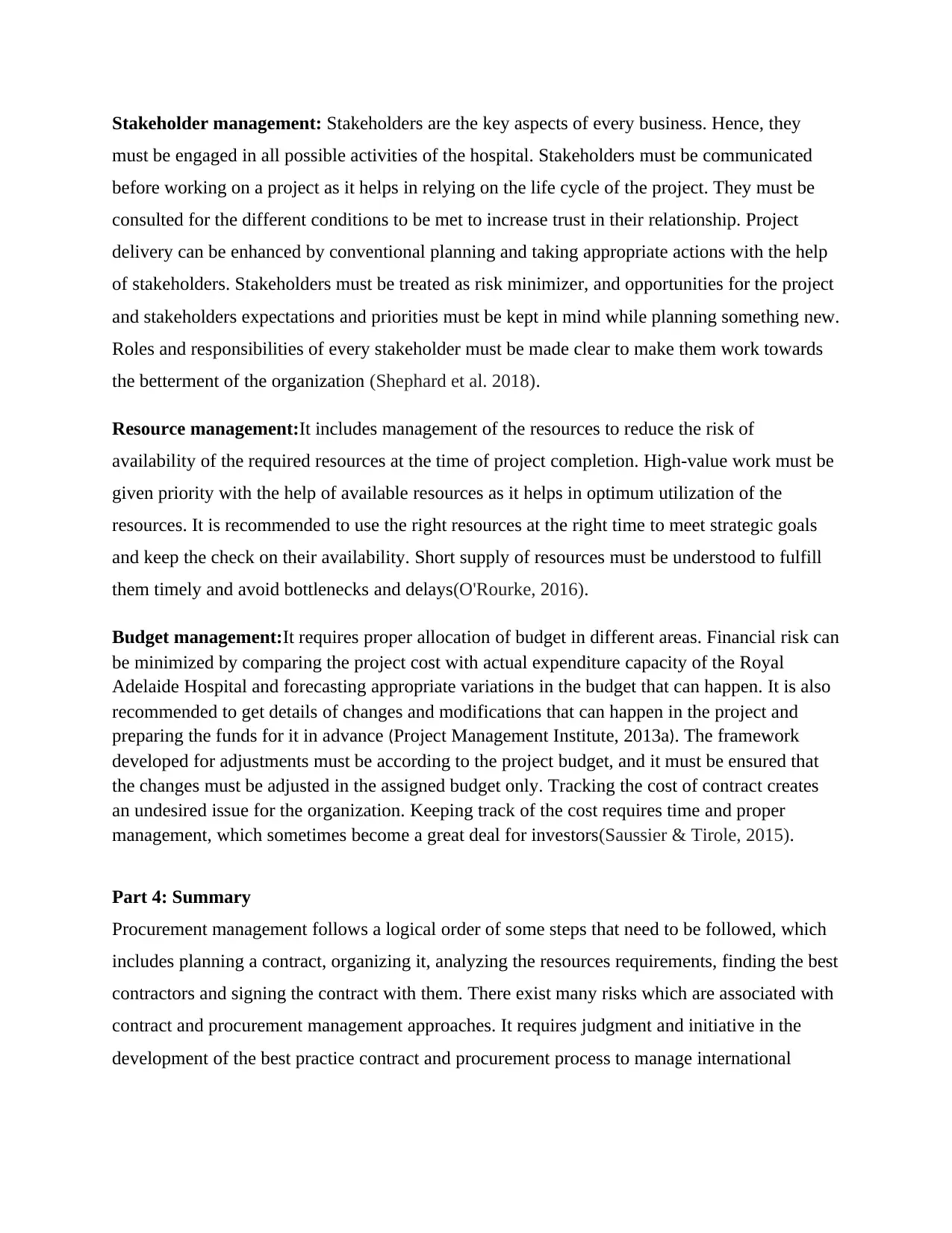
Stakeholder management: Stakeholders are the key aspects of every business. Hence, they
must be engaged in all possible activities of the hospital. Stakeholders must be communicated
before working on a project as it helps in relying on the life cycle of the project. They must be
consulted for the different conditions to be met to increase trust in their relationship. Project
delivery can be enhanced by conventional planning and taking appropriate actions with the help
of stakeholders. Stakeholders must be treated as risk minimizer, and opportunities for the project
and stakeholders expectations and priorities must be kept in mind while planning something new.
Roles and responsibilities of every stakeholder must be made clear to make them work towards
the betterment of the organization (Shephard et al. 2018).
Resource management:It includes management of the resources to reduce the risk of
availability of the required resources at the time of project completion. High-value work must be
given priority with the help of available resources as it helps in optimum utilization of the
resources. It is recommended to use the right resources at the right time to meet strategic goals
and keep the check on their availability. Short supply of resources must be understood to fulfill
them timely and avoid bottlenecks and delays(O'Rourke, 2016).
Budget management:It requires proper allocation of budget in different areas. Financial risk can
be minimized by comparing the project cost with actual expenditure capacity of the Royal
Adelaide Hospital and forecasting appropriate variations in the budget that can happen. It is also
recommended to get details of changes and modifications that can happen in the project and
preparing the funds for it in advance (Project Management Institute, 2013a). The framework
developed for adjustments must be according to the project budget, and it must be ensured that
the changes must be adjusted in the assigned budget only. Tracking the cost of contract creates
an undesired issue for the organization. Keeping track of the cost requires time and proper
management, which sometimes become a great deal for investors(Saussier & Tirole, 2015).
Part 4: Summary
Procurement management follows a logical order of some steps that need to be followed, which
includes planning a contract, organizing it, analyzing the resources requirements, finding the best
contractors and signing the contract with them. There exist many risks which are associated with
contract and procurement management approaches. It requires judgment and initiative in the
development of the best practice contract and procurement process to manage international
must be engaged in all possible activities of the hospital. Stakeholders must be communicated
before working on a project as it helps in relying on the life cycle of the project. They must be
consulted for the different conditions to be met to increase trust in their relationship. Project
delivery can be enhanced by conventional planning and taking appropriate actions with the help
of stakeholders. Stakeholders must be treated as risk minimizer, and opportunities for the project
and stakeholders expectations and priorities must be kept in mind while planning something new.
Roles and responsibilities of every stakeholder must be made clear to make them work towards
the betterment of the organization (Shephard et al. 2018).
Resource management:It includes management of the resources to reduce the risk of
availability of the required resources at the time of project completion. High-value work must be
given priority with the help of available resources as it helps in optimum utilization of the
resources. It is recommended to use the right resources at the right time to meet strategic goals
and keep the check on their availability. Short supply of resources must be understood to fulfill
them timely and avoid bottlenecks and delays(O'Rourke, 2016).
Budget management:It requires proper allocation of budget in different areas. Financial risk can
be minimized by comparing the project cost with actual expenditure capacity of the Royal
Adelaide Hospital and forecasting appropriate variations in the budget that can happen. It is also
recommended to get details of changes and modifications that can happen in the project and
preparing the funds for it in advance (Project Management Institute, 2013a). The framework
developed for adjustments must be according to the project budget, and it must be ensured that
the changes must be adjusted in the assigned budget only. Tracking the cost of contract creates
an undesired issue for the organization. Keeping track of the cost requires time and proper
management, which sometimes become a great deal for investors(Saussier & Tirole, 2015).
Part 4: Summary
Procurement management follows a logical order of some steps that need to be followed, which
includes planning a contract, organizing it, analyzing the resources requirements, finding the best
contractors and signing the contract with them. There exist many risks which are associated with
contract and procurement management approaches. It requires judgment and initiative in the
development of the best practice contract and procurement process to manage international
⊘ This is a preview!⊘
Do you want full access?
Subscribe today to unlock all pages.

Trusted by 1+ million students worldwide
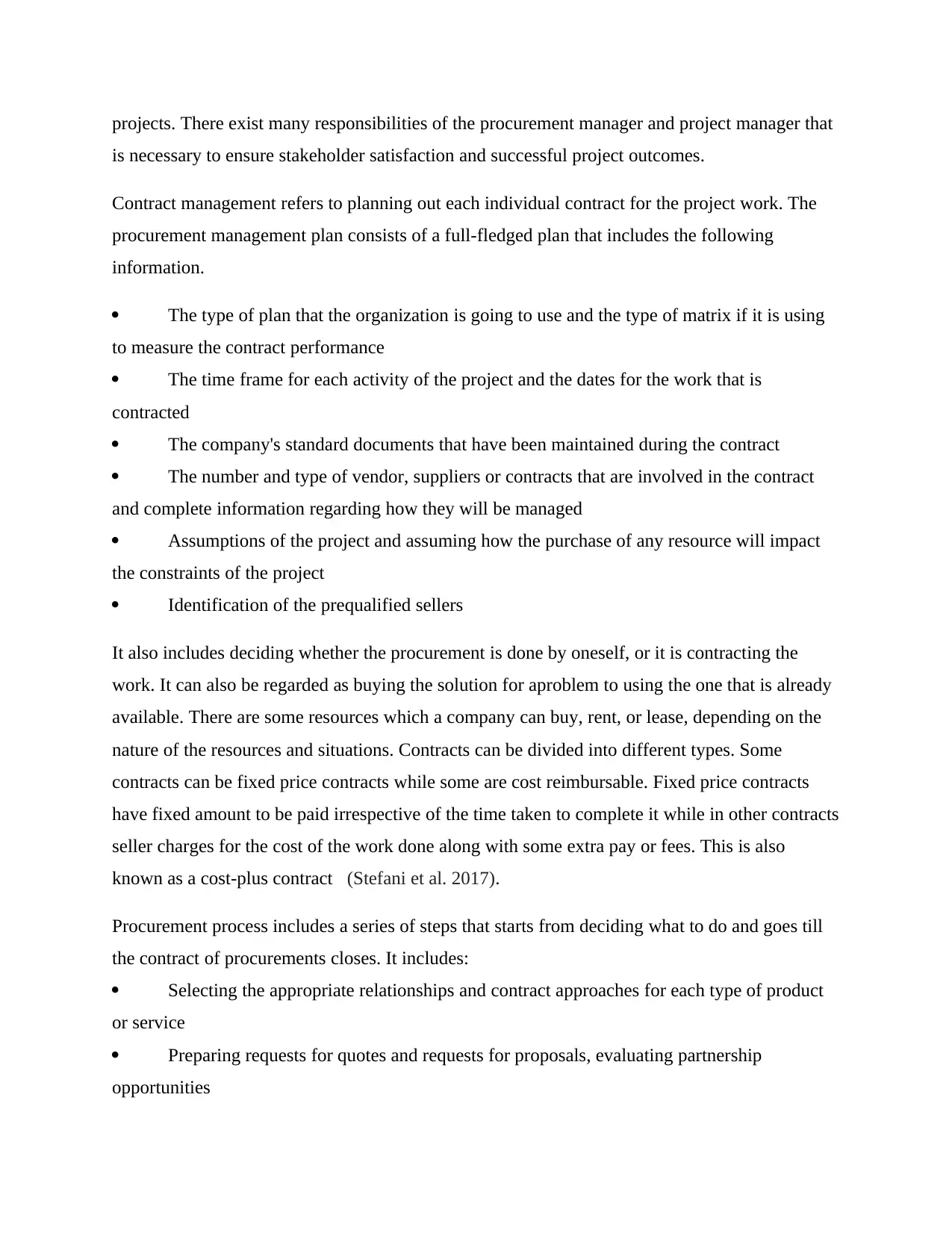
projects. There exist many responsibilities of the procurement manager and project manager that
is necessary to ensure stakeholder satisfaction and successful project outcomes.
Contract management refers to planning out each individual contract for the project work. The
procurement management plan consists of a full-fledged plan that includes the following
information.
The type of plan that the organization is going to use and the type of matrix if it is using
to measure the contract performance
The time frame for each activity of the project and the dates for the work that is
contracted
The company's standard documents that have been maintained during the contract
The number and type of vendor, suppliers or contracts that are involved in the contract
and complete information regarding how they will be managed
Assumptions of the project and assuming how the purchase of any resource will impact
the constraints of the project
Identification of the prequalified sellers
It also includes deciding whether the procurement is done by oneself, or it is contracting the
work. It can also be regarded as buying the solution for aproblem to using the one that is already
available. There are some resources which a company can buy, rent, or lease, depending on the
nature of the resources and situations. Contracts can be divided into different types. Some
contracts can be fixed price contracts while some are cost reimbursable. Fixed price contracts
have fixed amount to be paid irrespective of the time taken to complete it while in other contracts
seller charges for the cost of the work done along with some extra pay or fees. This is also
known as a cost-plus contract (Stefani et al. 2017).
Procurement process includes a series of steps that starts from deciding what to do and goes till
the contract of procurements closes. It includes:
Selecting the appropriate relationships and contract approaches for each type of product
or service
Preparing requests for quotes and requests for proposals, evaluating partnership
opportunities
is necessary to ensure stakeholder satisfaction and successful project outcomes.
Contract management refers to planning out each individual contract for the project work. The
procurement management plan consists of a full-fledged plan that includes the following
information.
The type of plan that the organization is going to use and the type of matrix if it is using
to measure the contract performance
The time frame for each activity of the project and the dates for the work that is
contracted
The company's standard documents that have been maintained during the contract
The number and type of vendor, suppliers or contracts that are involved in the contract
and complete information regarding how they will be managed
Assumptions of the project and assuming how the purchase of any resource will impact
the constraints of the project
Identification of the prequalified sellers
It also includes deciding whether the procurement is done by oneself, or it is contracting the
work. It can also be regarded as buying the solution for aproblem to using the one that is already
available. There are some resources which a company can buy, rent, or lease, depending on the
nature of the resources and situations. Contracts can be divided into different types. Some
contracts can be fixed price contracts while some are cost reimbursable. Fixed price contracts
have fixed amount to be paid irrespective of the time taken to complete it while in other contracts
seller charges for the cost of the work done along with some extra pay or fees. This is also
known as a cost-plus contract (Stefani et al. 2017).
Procurement process includes a series of steps that starts from deciding what to do and goes till
the contract of procurements closes. It includes:
Selecting the appropriate relationships and contract approaches for each type of product
or service
Preparing requests for quotes and requests for proposals, evaluating partnership
opportunities
Paraphrase This Document
Need a fresh take? Get an instant paraphrase of this document with our AI Paraphraser
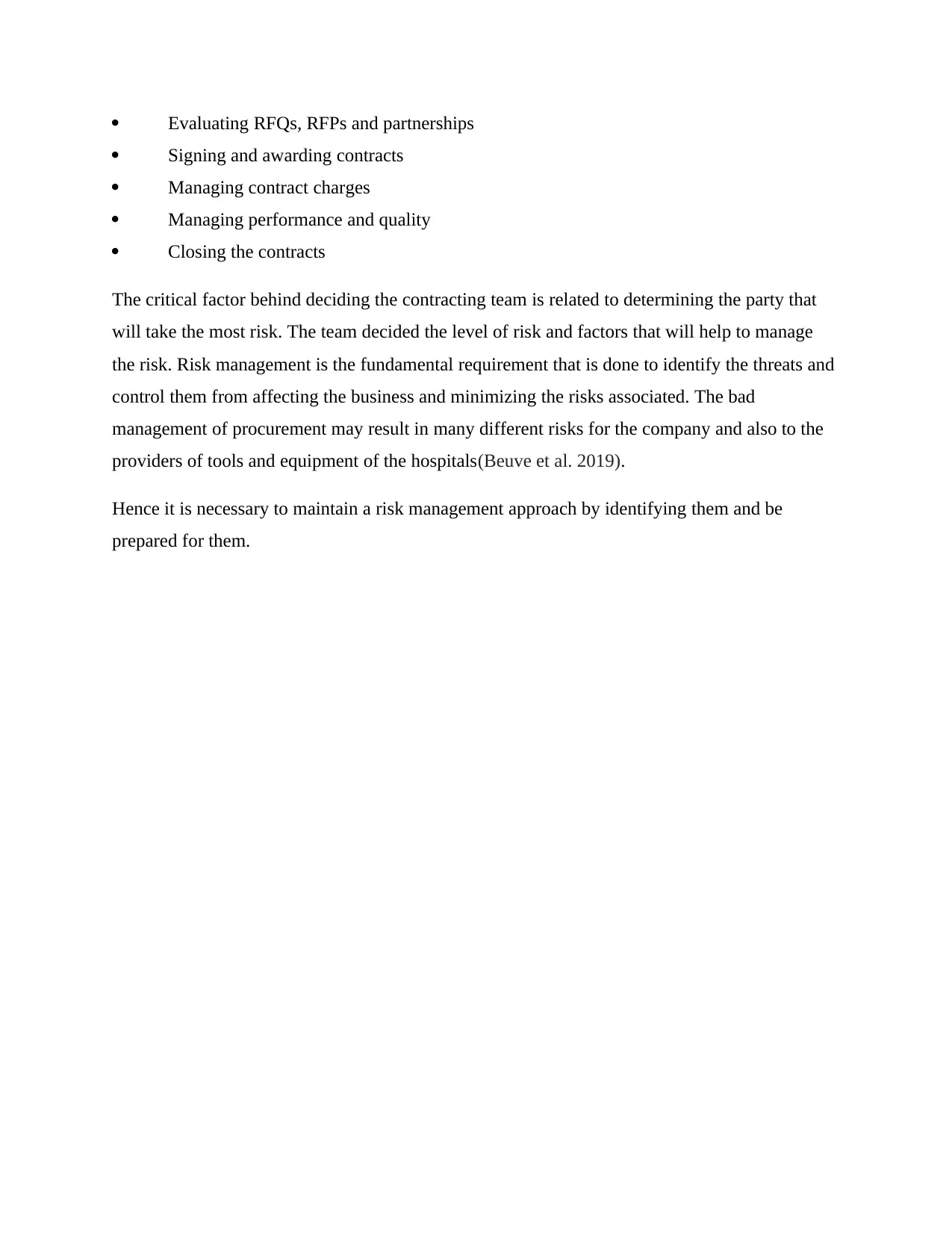
Evaluating RFQs, RFPs and partnerships
Signing and awarding contracts
Managing contract charges
Managing performance and quality
Closing the contracts
The critical factor behind deciding the contracting team is related to determining the party that
will take the most risk. The team decided the level of risk and factors that will help to manage
the risk. Risk management is the fundamental requirement that is done to identify the threats and
control them from affecting the business and minimizing the risks associated. The bad
management of procurement may result in many different risks for the company and also to the
providers of tools and equipment of the hospitals(Beuve et al. 2019).
Hence it is necessary to maintain a risk management approach by identifying them and be
prepared for them.
Signing and awarding contracts
Managing contract charges
Managing performance and quality
Closing the contracts
The critical factor behind deciding the contracting team is related to determining the party that
will take the most risk. The team decided the level of risk and factors that will help to manage
the risk. Risk management is the fundamental requirement that is done to identify the threats and
control them from affecting the business and minimizing the risks associated. The bad
management of procurement may result in many different risks for the company and also to the
providers of tools and equipment of the hospitals(Beuve et al. 2019).
Hence it is necessary to maintain a risk management approach by identifying them and be
prepared for them.
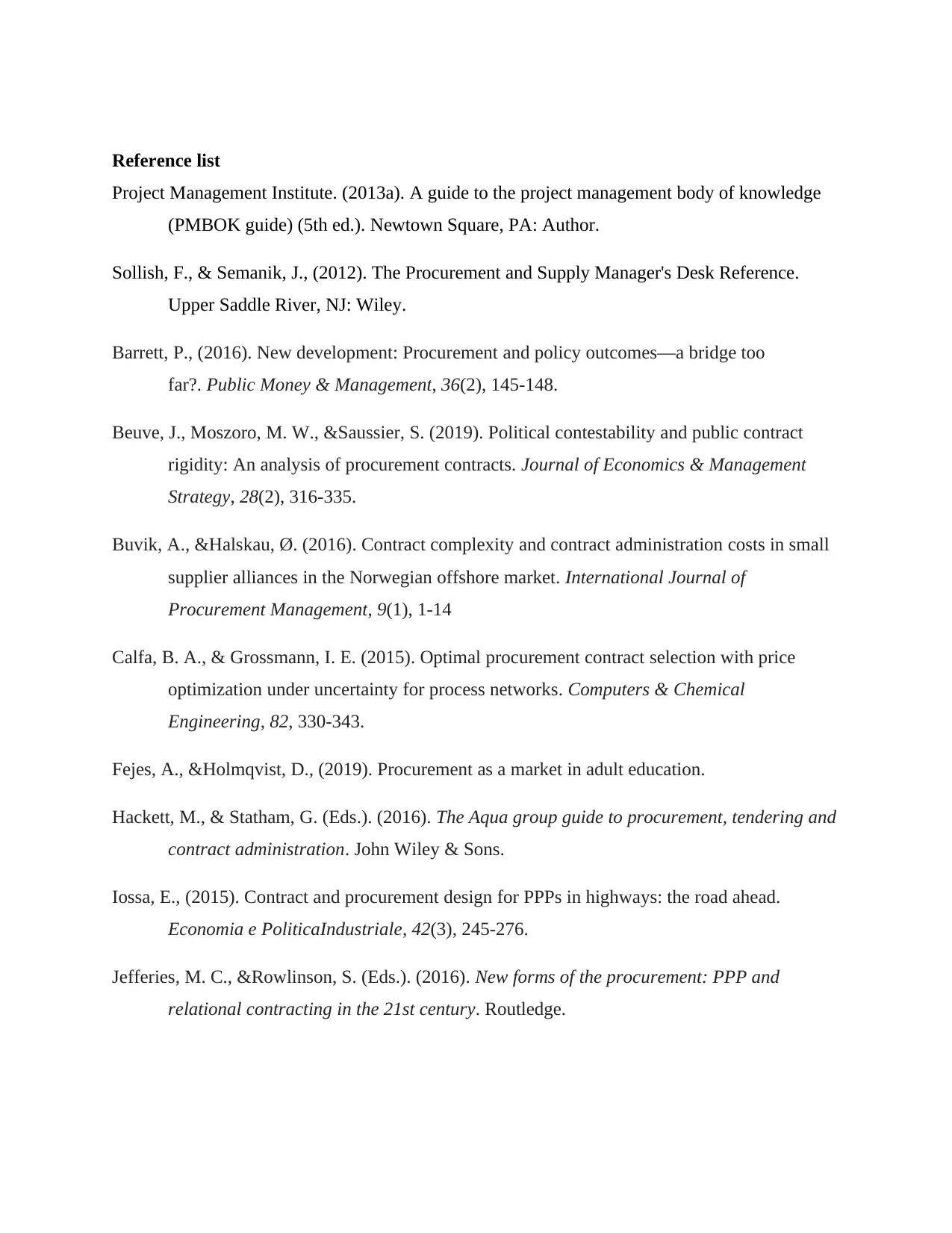
Reference list
Project Management Institute. (2013a). A guide to the project management body of knowledge
(PMBOK guide) (5th ed.). Newtown Square, PA: Author.
Sollish, F., & Semanik, J., (2012). The Procurement and Supply Manager's Desk Reference.
Upper Saddle River, NJ: Wiley.
Barrett, P., (2016). New development: Procurement and policy outcomes—a bridge too
far?. Public Money & Management, 36(2), 145-148.
Beuve, J., Moszoro, M. W., &Saussier, S. (2019). Political contestability and public contract
rigidity: An analysis of procurement contracts. Journal of Economics & Management
Strategy, 28(2), 316-335.
Buvik, A., &Halskau, Ø. (2016). Contract complexity and contract administration costs in small
supplier alliances in the Norwegian offshore market. International Journal of
Procurement Management, 9(1), 1-14
Calfa, B. A., & Grossmann, I. E. (2015). Optimal procurement contract selection with price
optimization under uncertainty for process networks. Computers & Chemical
Engineering, 82, 330-343.
Fejes, A., &Holmqvist, D., (2019). Procurement as a market in adult education.
Hackett, M., & Statham, G. (Eds.). (2016). The Aqua group guide to procurement, tendering and
contract administration. John Wiley & Sons.
Iossa, E., (2015). Contract and procurement design for PPPs in highways: the road ahead.
Economia e PoliticaIndustriale, 42(3), 245-276.
Jefferies, M. C., &Rowlinson, S. (Eds.). (2016). New forms of the procurement: PPP and
relational contracting in the 21st century. Routledge.
Project Management Institute. (2013a). A guide to the project management body of knowledge
(PMBOK guide) (5th ed.). Newtown Square, PA: Author.
Sollish, F., & Semanik, J., (2012). The Procurement and Supply Manager's Desk Reference.
Upper Saddle River, NJ: Wiley.
Barrett, P., (2016). New development: Procurement and policy outcomes—a bridge too
far?. Public Money & Management, 36(2), 145-148.
Beuve, J., Moszoro, M. W., &Saussier, S. (2019). Political contestability and public contract
rigidity: An analysis of procurement contracts. Journal of Economics & Management
Strategy, 28(2), 316-335.
Buvik, A., &Halskau, Ø. (2016). Contract complexity and contract administration costs in small
supplier alliances in the Norwegian offshore market. International Journal of
Procurement Management, 9(1), 1-14
Calfa, B. A., & Grossmann, I. E. (2015). Optimal procurement contract selection with price
optimization under uncertainty for process networks. Computers & Chemical
Engineering, 82, 330-343.
Fejes, A., &Holmqvist, D., (2019). Procurement as a market in adult education.
Hackett, M., & Statham, G. (Eds.). (2016). The Aqua group guide to procurement, tendering and
contract administration. John Wiley & Sons.
Iossa, E., (2015). Contract and procurement design for PPPs in highways: the road ahead.
Economia e PoliticaIndustriale, 42(3), 245-276.
Jefferies, M. C., &Rowlinson, S. (Eds.). (2016). New forms of the procurement: PPP and
relational contracting in the 21st century. Routledge.
⊘ This is a preview!⊘
Do you want full access?
Subscribe today to unlock all pages.

Trusted by 1+ million students worldwide
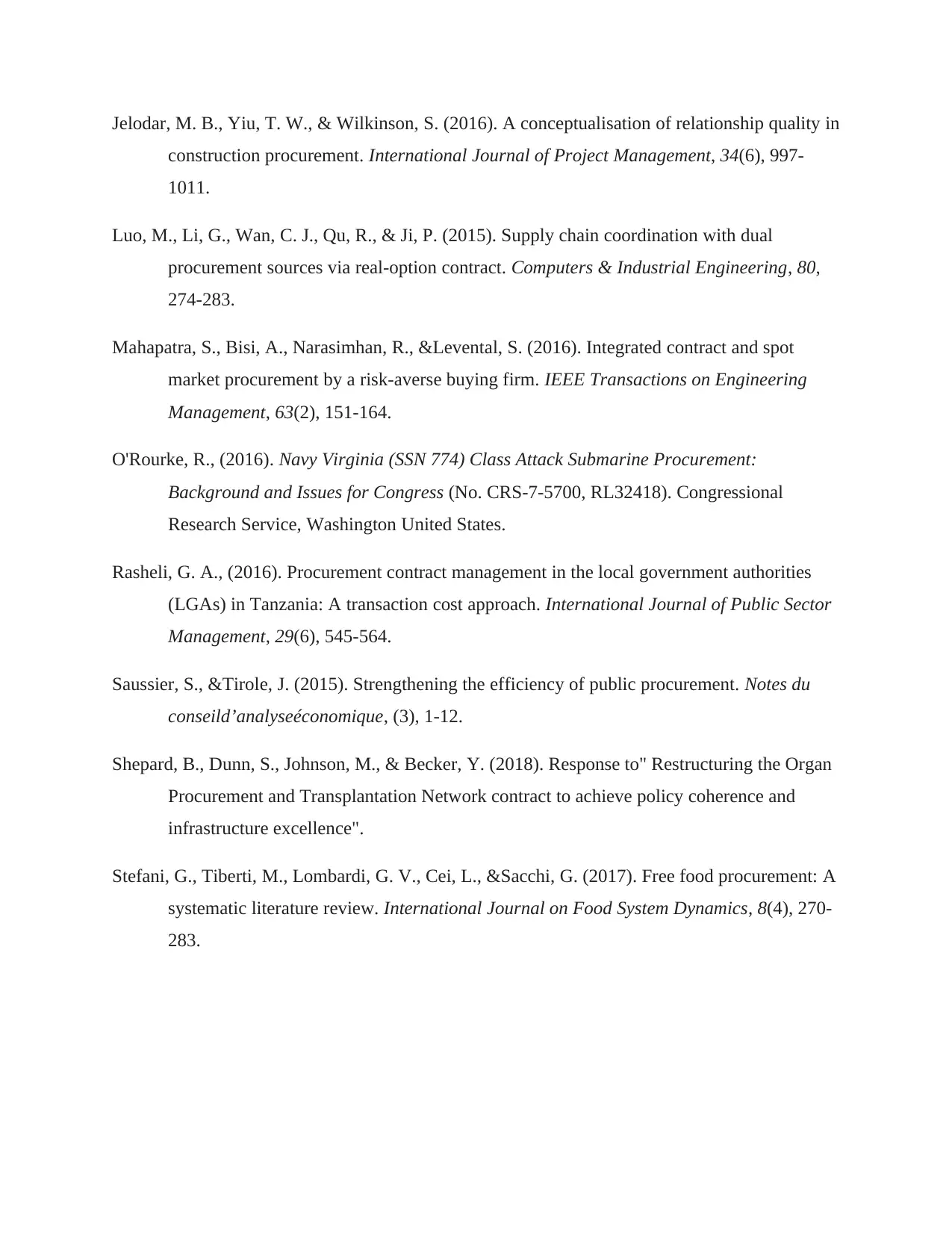
Jelodar, M. B., Yiu, T. W., & Wilkinson, S. (2016). A conceptualisation of relationship quality in
construction procurement. International Journal of Project Management, 34(6), 997-
1011.
Luo, M., Li, G., Wan, C. J., Qu, R., & Ji, P. (2015). Supply chain coordination with dual
procurement sources via real-option contract. Computers & Industrial Engineering, 80,
274-283.
Mahapatra, S., Bisi, A., Narasimhan, R., &Levental, S. (2016). Integrated contract and spot
market procurement by a risk-averse buying firm. IEEE Transactions on Engineering
Management, 63(2), 151-164.
O'Rourke, R., (2016). Navy Virginia (SSN 774) Class Attack Submarine Procurement:
Background and Issues for Congress (No. CRS-7-5700, RL32418). Congressional
Research Service, Washington United States.
Rasheli, G. A., (2016). Procurement contract management in the local government authorities
(LGAs) in Tanzania: A transaction cost approach. International Journal of Public Sector
Management, 29(6), 545-564.
Saussier, S., &Tirole, J. (2015). Strengthening the efficiency of public procurement. Notes du
conseild’analyseéconomique, (3), 1-12.
Shepard, B., Dunn, S., Johnson, M., & Becker, Y. (2018). Response to" Restructuring the Organ
Procurement and Transplantation Network contract to achieve policy coherence and
infrastructure excellence".
Stefani, G., Tiberti, M., Lombardi, G. V., Cei, L., &Sacchi, G. (2017). Free food procurement: A
systematic literature review. International Journal on Food System Dynamics, 8(4), 270-
283.
construction procurement. International Journal of Project Management, 34(6), 997-
1011.
Luo, M., Li, G., Wan, C. J., Qu, R., & Ji, P. (2015). Supply chain coordination with dual
procurement sources via real-option contract. Computers & Industrial Engineering, 80,
274-283.
Mahapatra, S., Bisi, A., Narasimhan, R., &Levental, S. (2016). Integrated contract and spot
market procurement by a risk-averse buying firm. IEEE Transactions on Engineering
Management, 63(2), 151-164.
O'Rourke, R., (2016). Navy Virginia (SSN 774) Class Attack Submarine Procurement:
Background and Issues for Congress (No. CRS-7-5700, RL32418). Congressional
Research Service, Washington United States.
Rasheli, G. A., (2016). Procurement contract management in the local government authorities
(LGAs) in Tanzania: A transaction cost approach. International Journal of Public Sector
Management, 29(6), 545-564.
Saussier, S., &Tirole, J. (2015). Strengthening the efficiency of public procurement. Notes du
conseild’analyseéconomique, (3), 1-12.
Shepard, B., Dunn, S., Johnson, M., & Becker, Y. (2018). Response to" Restructuring the Organ
Procurement and Transplantation Network contract to achieve policy coherence and
infrastructure excellence".
Stefani, G., Tiberti, M., Lombardi, G. V., Cei, L., &Sacchi, G. (2017). Free food procurement: A
systematic literature review. International Journal on Food System Dynamics, 8(4), 270-
283.
1 out of 10
Related Documents
Your All-in-One AI-Powered Toolkit for Academic Success.
+13062052269
info@desklib.com
Available 24*7 on WhatsApp / Email
![[object Object]](/_next/static/media/star-bottom.7253800d.svg)
Unlock your academic potential
Copyright © 2020–2025 A2Z Services. All Rights Reserved. Developed and managed by ZUCOL.





